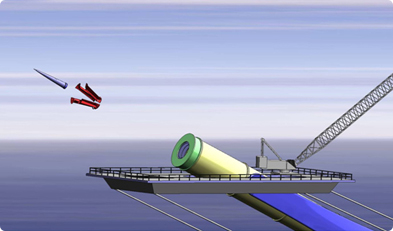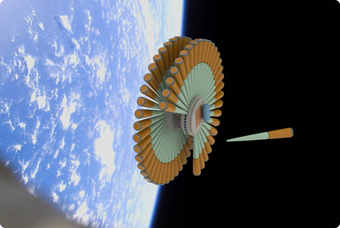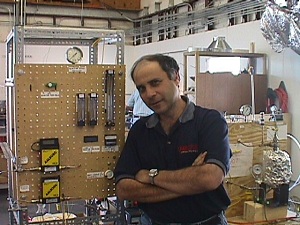by Richard Obousy
After a stint as project leader for the Project Icarus starship design study, Richard Obousy now serves as Module Lead Primary Propulsion for the effort. Dr. Obousy’s doctoral work at Baylor University focused on the possibility that dark energy could be an artifact of Casimir energy in extra dimensions. For Icarus, he has pivoted to the study of fusion propulsion systems for this ongoing reworking of the original Project Daedalus concept. He’s also fascinated with the possibilities of getting off our planet more easily and establishing a human presence on Mars, all ideas he was able to explore at the Mars Society’s latest meeting, from which this report.
As a native of Texas, living only a couple of hours drive from Dallas, I was thrilled to discover that that was where the Mars Society planned to hold its 14th International Mars Society Convention. This was a perfect opportunity for me to meet space enthusiasts, to present to this community some of the ideas coming out of Project Icarus, and to learn from a successful non-profit foundation how to engage with its members, while delivering something valuable to the field of Mars research.
For those not familiar with the Mars Society, it is a non-profit charity founded in 1998 by Mars exploration luminary Bob Zubrin. The society is devoted to the cause of exploring and, ultimately settling, the red planet. The society has over 4,000 members and is active in over 50 countries worldwide. A large number of volunteers engage in public outreach programs in an effort to foster support for Mars research and exploration, and a notable feature of the society is its commitment to ongoing technical projects – the most exciting of which are arguably the research stations that the society has set up in hostile environments. The purpose of these research stations is to simulate the conditions and environment that early Mars explorers might face. Currently there are research stations in both an arctic environment and a desert environment, representing evidence for what can be accomplished by a devoted collection of volunteers.
The conference itself spanned four days, as numerous presentations relating to Mars exploration were delivered by a selection of scientists, engineers, and private hobbyists. An entire afternoon session was devoted to the topic of nuclear rockets and several of the original engineers involved in the NERVA (Nuclear Engine for Rocket Vehicle Exploration) program presented. NERVA was a fascinating facet of the US space research program, leading to nuclear rocket engines actually being certified as flight worthy in the late 60s, after extensive testing. The untimely cancellation of NERVA was largely a result of the Nixon administration’s lack of interest in the manned exploration of Mars, which it saw as both costly and strategically irrelevant, with the space race already ‘won’ after the successful Apollo moon landings.
One talk that still resonates with me was given by Dr. John Hunter, an ex-theoretical physicist turned space engineer. Hunter is the director of Quicklaunch, a company planning to use a light gas gun to launch payloads into space. The basic idea behind the gas gun is to use a large piston which imparts force to a gaseous working fluid through a smaller diameter barrel which contains the projectile to be accelerated. The gun that Hunter is working on gives the projectile, a single stage rocket engine plus payload, an initial speed of 6 km/s which launches it to approximately 100 km altitude.
Image: Quicklaunch’s larger QL-1000 systems will be built after the smaller QL-100 versions have proven high reliability. Each QL-1000 is a $500M system delivering up to 5 launches/day. After servicing one customer they can switch azimuth and launch angle to accommodate a different customer. At T=0 the vehicle leaves the muzzle and the four sabot petals are stripped away. Meanwhile the muffler closes behind the vehicle, capturing 99% of the hydrogen to be recycled. Credit: Quicklaunch.
At this point, the rocket engine fires and gives the projectile the final kick it needs to circularize its orbit. Using this technique, Hunter believes that he will be able to attain launch costs of $500/lb. Contrast this with the Space Shuttle costs of around $10,000/lb and the economics quickly makes sense. Even Elon Musk’s heavy Falcon launcher will be around the $1000/lb mark, so Hunter’s gas gun looks like an attractive option! One obvious limitation is that the high gee forces (~100 g’s) experienced during the initial launch exclude the possibility of human passengers, and so the gas gun will likely focus on launching propellant payloads. The resulting fuel ‘depots’ could enable future manned lunar and Mars exploration, if Quicklaunch were used in tandem with traditional launch systems. I encourage anyone interested in this fascinating technology to take a look at the Quicklaunch website which contains more details on their plans and accomplishments to date.
Image: Quicklaunch in Earth orbit. At T=9 minutes final maneuvering is performed until the vehicle docks with the depot. At that point a line is opened allowing the propellant to communicate with the rest of the depot. Propellant types will include both storable and cryogenics. Standard propellants are RP-1, LH2 and LOX. In addition xenon, argon and water can be delivered. Credit: Quicklaunch.
Zubrin himself gave a fascinating talk titled “VASIMR: Hoax or Silver Bullet,” arguing hotly that Chang-Diaz’s VASIMR is unlikely to produce any better efficiency than current ion engines, and that the promises being made regarding the utility of the engine are exaggerated. Zubrin believes that research into VASIMR is nothing more than a distraction, since NASA is adopting the mindset that the VASIMR is a necessary technological precursor for a manned mission to Mars. Zubrin argues that a manned Mars landing can be accomplished using off-the-shelf technology available today, for a small fraction of the $450 billion price tag that NASA initially suggested in the “90-day Study” in 1989.
Another of Zubrin’s talks, titled the “Transorbital Railroad,” urges NASA to devote a budget of $1.2 billion per year to pay for launches, possibly using SpaceX technology, to deliver payloads into orbit. The payload mass would be sold to paying customers at $50/kg, and if there were unused payload space, this could be filled with tanks containing water, kerosene and liquid oxygen. These tanks would then be left in orbit and made available to anyone who could reach them. Using the Falcon Heavy launch vehicle, Zubrin estimates that 765 metric tonnes could be launched annually. The main thrust behind this heavily government subsidized plan would be to create a space-based economic sector welcoming to entrepreneurs. His belief is that the tax revenues that would be generated from this endeavor would pay for the Transorbital Railroad many times over. The name Transorbital Railroad is adopted from the history of the settlement of the American West, where the building of the Transcontinental Railroad opened up a plethora of economic opportunities for Americans of the era.
Image: Mars Society founder Robert Zubrin. Credit: The Mars Society.
There were many more talks at the conference, equally worthy of discussion, but the ones reviewed here probably had the biggest impact on me for one reason or another. I was happy to meet with Bob Zubrin at the speakers party one night, and share with him some of the exciting work being conducted by Project Icarus, which was met with enthusiasm by Bob – a former nuclear engineer. Being involved in the area of interstellar research, I was reaching, somewhat, into a community whose goals vary from my own field. However, I felt that there was a common theme and a collective unity that binds the Mars Society with those of non-profits like the Tau Zero Foundation and Icarus Interstellar – namely a core of dedicated volunteers pushing a vision forward, while being supported by a network of collaborators spread across the globe. The success of the Mars Society is a testament to what can be accomplished by such volunteers and I was genuinely happy to be a part of that last weekend.







Thanks for your report. The dream of seeing exploration with humans beyond low earth orbit has receded significantly in my lifetime, but I try to keep up the hope. Good luck on project Icarus too!
“Hunter believes that he will be able to attain launch costs of $500/lb. …Musk’s heavy Falcon launcher will be around the $1000/lb mark, so Hunter’s gas gun looks like an attractive option!”
But Musk has said that with re-usability the cost on Falcon could be as low as $100/lb.
As a member of the Mars Society as well as a regular reader here at Centauri Dreams, I applaud inclusion of this coverage here. Interest in and enthusiasm for space-related technologies, discoveries, and projects must not become insular. Information about everything from abstract science, to interstellar mission plans, to near-term astronautics, all needs a much wider audience than it presently has, and it’s great to see advocacy organizations and sites like Centauri Dreams willing to intercommunicate about the programs and projects of other advocacy groups. Thanks for featuring the Mars Society here for a day!
We must inspire more of the next generation to be interested in space-related information and advances of every sort, in the hope some of them will choose engineering and science careers. We, and our children, must directly act to build the future that we want for our species, not be spectators waiting for or expecting our governments to fund it. Every space advocacy organization is trying to do this in its own way, but each can help catalyze overall progress just a little bit more by showing mutual support for other groups likewise pushing for humanity’s future in space.
Andrew W,
Musk is the first to admit that getting to $100/lb will be very hard. Making rocket stages reusable, usefully so, is very difficult. SpaceX are working on the problems, but they’re non-trivial and low cost reusability is not yet proven possible with SpaceX Falcons. Other approaches are worth investigating.
I’m sure many are thinking my same thought, but are afraid to express it. What stirs me most is pioneer explorers accepting very high risks of mortality, and beating them. To me the “Mars direct” plan looked incredibly inspiring, and is affordable enough to work, if only we could persuade governments to allow a fully informed crew to accept the risk of true heroes.
There is no difficulty in finding brave, dedicated people willing to take the risks to be part of a Mars mission. But courage alone isn’t enough. The governments won’t fund such a hugely expensive and prestige risking project. It is not only the risk of losing astronauts but also of a costly and humilating mission failure. I think we must get the travel time down by designing fast, robust, well-shielded spacecraft. That sounds like some kind of nuclear propulsion to me. This will be an essential step before a crewed Mars mission becomes viable. It must be done sooner or later to allow crewed exploration of the rest of the Solar System anyway.
Anything less for a Mars mission could prove to be a very expensive way to kill astronauts. Perhaps we will have to wait a little while longer until better engines are developed.
The future of affordable space access lies in competing launch technologies. For the access to Low Earth Orbit at 1/10 the lowest current cost check… http://www.facebook.com/pages/Quicklaunch/170146893049825?sk=wall This impressive explosion, large flash and meteoric egress creates a testosterone elevation effect that resonates with most men….
Check the 4th entry, its a news story 1:43 minute length. It shows the gas launcher shooting scram jets at Mach 9. The nanosecond camera footage gives you a glimpse of the projectile before it hits the sand pit and evaporates.
Can I just point out that Zubrin has been saying “we’re only ten years away from Mars!” since around 1990? And “we can do a Mars trip CHEAP!” for at least that long.
We’re a lot more than 10 years away from Mars. And — barring some unexpected, major breakthrough — $450 billion to put a human on Mars is probably a very, very conservative estimate.
Incidentally, I’d be happy to make a $100 side bet that we won’t see $50/kg to LEO within the next 20 years. It’s a bet I’d be delighted to lose!
As for the attacks on Chang-Diaz… you might think the guy who came up with the Nuclear Salt Water Rocket would be a little more sympathetic to other folks’ far-out ideas.
Doug M.
News release: 2012-286 Sept. 11, 2012
NASA Orbiter Observations Point to ‘Dry Ice’ Snowfall on Mars
The full version of this story with accompanying images is at:
http://www.jpl.nasa.gov/news/news.php?release=2012-286&cid=release_2012-286
PASADENA, Calif. — NASA’s Mars Reconnaissance Orbiter data have given scientists the clearest evidence yet of carbon-dioxide snowfalls on Mars. This reveals the only known example of carbon-dioxide snow falling anywhere in our solar system.
Frozen carbon dioxide, better known as “dry ice,” requires temperatures of about minus 193 degrees Fahrenheit (minus 125 Celsius), which is much colder than needed for freezing water. Carbon-dioxide snow reminds scientists that although some parts of Mars may look quite Earth-like, the Red Planet is very different. The report is being published in the Journal of Geophysical Research.
“These are the first definitive detections of carbon-dioxide snow clouds,” said the report’s lead author, Paul Hayne of NASA’s Jet Propulsion Laboratory in Pasadena, Calif. “We firmly establish the clouds are composed of carbon dioxide — flakes of Martian air — and they are thick enough to result in snowfall accumulation at the surface.”
The snowfalls occurred from clouds around the Red Planet’s south pole in winter. The presence of carbon-dioxide ice in Mars’ seasonal and residual southern polar caps has been known for decades. Also, NASA’s Phoenix Lander mission in 2008 observed falling water-ice snow on northern Mars.
Hayne and six co-authors analyzed data gained by looking at clouds straight overhead and sideways with the Mars Climate Sounder, one of six instruments on the Mars Reconnaissance Orbiter. This instrument records brightness in nine wavebands of visible and infrared light as a way to examine particles and gases in the Martian atmosphere. The analysis was conducted while Hayne was a post-doctoral fellow at the California Institute of Technology in Pasadena.
The data provide information about temperatures, particle sizes and their concentrations. The new analysis is based on data from observations in the south polar region during southern Mars winter in 2006-2007, identifying a tall carbon-dioxide cloud about 300 miles (500 kilometers) in diameter persisting over the pole and smaller, shorter-lived, lower-altitude carbon dioxide ice clouds at latitudes from 70 to 80 degrees south.
“One line of evidence for snow is that the carbon-dioxide ice particles in the clouds are large enough to fall to the ground during the lifespan of the clouds,” co-author David Kass of JPL said. “Another comes from observations when the instrument is pointed toward the horizon, instead of down at the surface. The infrared spectra signature of the clouds viewed from this angle is clearly carbon-dioxide ice particles and they extend to the surface. By observing this way, the Mars Climate Sounder is able to distinguish the particles in the atmosphere from the dry ice on the surface.”
Mars’ south polar residual ice cap is the only place on the Red Planet where frozen carbon dioxide persists on the surface year-round. Just how the carbon dioxide from Mars’ atmosphere gets deposited has been in question. It is unclear whether it occurs as snow or by freezing out at ground level as frost. These results show snowfall is especially vigorous on top of the residual cap.
“The finding of snowfall could mean that the type of deposition — snow or frost — is somehow linked to the year-to-year preservation of the residual cap,” Hayne said.
JPL, a division of the California Institute of Technology in Pasadena, provided the Mars Climate Sounder instrument and manages the Mars Reconnaissance Orbiter Project for NASA’s Science Mission Directorate in Washington.
For more information about the Mars Reconnaissance Orbiter, visit: http://www.nasa.gov/mro and http://mars.jpl.nasa.gov/mro .
Guy Webster 818-354-5011
Jet Propulsion Laboratory, Pasadena, Calif.
guy.webster@jpl.nasa.gov
Dwayne Brown 202-358-1726
Headquarters, Washington
dwayne.c.brown@nasa.gov
http://blog.oup.com/2012/12/oxford-companion-to-mars/
An Oxford Companion to Mars
Posted on Sunday, December 9th, 2012 at 3:30 am
By Alice Northover
With our announcement of Place of the Year 2012 and NASA’s announcement at the American Geophysical Union on December 3rd, and a week full of posts about Mars, what better way to wrap things up than by pulling together information from across Oxford’s resources to provide some background on the Red Planet.